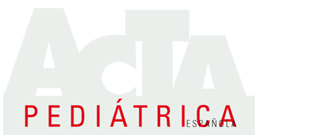Mostrando artículos por etiqueta: Rectorragia
Publicado en
Nutrición infantil
Proctocolitis hemorrágica en lactante exclusivamente alimentado al pecho
Proctocolitis in an exclusively breastfed infant
M. Barrios López, C. García Rebollar1, E. Medina BenítezSección de Gastroenterología. Departamento de Pediatría. Hospital Universitario «12 de Octubre». 1Pediatra de Atención Primaria. Centro de Salud Calesas. Área 11. Madrid
Publicado en
Notas clínicas
Úlcera rectal solitaria como causa infrecuente de rectorragia
Solitary rectal ulcer syndrome as a rare cause of rectal bleeding
M. Blanco Rodríguez1, S. Rado Peralta1, C. Ruiz Serrano1, S. Córdova2, G. Pérez Tejerizo31Servicios de Pediatría, 2Anatomía Patológica y 3Cirugía Pediátrica. Fundación Jiménez Díaz-CAPIO. Universidad Autónoma de Madrid














